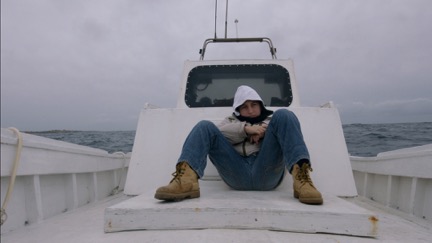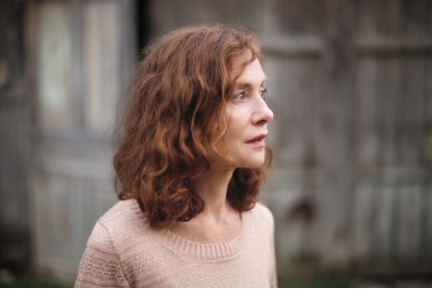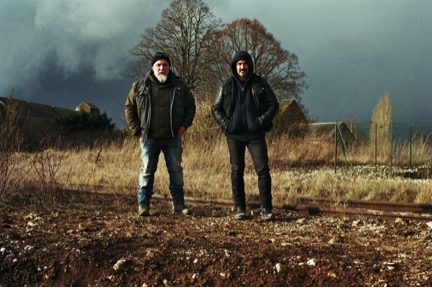Over the Fence, Across the Water: The 66th Berlin Film Festival
Skip other details (including permanent urls, DOI, citation information)
: This work is licensed under a Creative Commons Attribution 3.0 License. Please contact [email protected] to use this work in a way not covered by the license.
For more information, read Michigan Publishing's access and usage policy.
When the inaugural Berlinale took place, in the summer of 1951, Germany was still very much devastated by the effects of World War II, the Holocaust, and the millions of displaced people still pouring in from its former Eastern territories. Today, more than sixty years later, Western Europe is again experiencing a major refugee crisis, with Germany very much at the center, due to Angela Merkel’s confident commitment “wir schaffen das!”—her version of “Yes, we can!” It is estimated that alone in 2015, Germany took in over one million refugees, some 80,000 of them currently housed in Berlin.
Given the Festival’s long tradition of showcasing political films, it came as no surprise that the refugee crisis would take center stage this year, both on- and off-screen. In the opening ceremony, host Anke Engelke joked that there would be no “Obergrenze” (upper limit) for the number of awards jury president Meryl Streep might win—a pun on the much debated cap, opposed by Merkel, on the number of refugees Germany can take in. George Clooney, here to promote the Coen brothers’ Hail, Caesar!, which opened the Berlinale to much applause and laughter, had a private chat with Merkel about this issue, with Clooney calling Merkel “a beacon of light” in dark times. While locals are more skeptical about how much longer Merkel can sustain her position vis-à-vis the growing opposition within her own party and woeful lack of support in much of Europe, Clooney’s interest will hopefully prove more than a publicity stunt.
The Berlinale’s reputation as a political festival is often accompanied by the suspicion that the selected films are well-meaning, rather than well-made—a criticism that might apply to Spike Lee’s overwrought Chi-Raq, screening here out of competition, but not to the shocking, intensely human documentary Fuocoammare/Fire at Sea by Gianfranco Rosi, a deserving winner of the Golden Bear. Rosi’s film focuses on the everyday rather than the sensational to portray the grave refugee problem on the small Italian island of Lampedusa, just off the coast of Africa. It follows Samuele, a cheeky twelve-year-old who serves as our guide to the island and who does the things boys his age do—complain about school, hunt birds with his sling-shot, and loudly slurp his pasta. At his grandmother’s house, a radio report about the shipwreck of a migrant boat hints that the refugees, though largely invisible to the islanders, are nevertheless present. When a medical exam reveals that Samuele has a lazy eye that needs to be corrected with a patch, this diagnosis becomes a metaphor for all Europeans turning a blind eye towards the tragedy taking place next door.

An estimated 450,000 refugees have arrived on Lampedusa in recent years, while some 15,000 died at sea. Dottore Bartolo, the only physician for the 6,000 inhabitants, has been present at every landing of rescued migrants for the last thirty years. The anchor of humanity in the film, we watch him perform an ultrasound on a rescued woman and draw blood from a person who drowned. In one of the most powerful scenes, a rescued man sums up his ordeal in a mixture of prayer and rap: “It’s risky in life/not to take risks/because life itself is a risk.” Deflecting the question of whether his film advocates a political agenda, Rosi explained, “what it really does is bear witness to a tragedy that is happening right in front of our eyes. We are all eyewitnesses. Unlike with the Holocaust or Ruanda, we have images simultaneously, not just afterwards. Nobody can say ‘we did not know.’”
While many parts of Europe are currently fortifying their frontiers, a militarized border has long existed between San Diego and Tijuana, erected to stem the influx of people from Latin America. Rafi Pitts’ drama Soy Nero adds an interesting twist to the substantial cycle of films that deals with life on both sides of the border. Charismatic young Nero (Johnny Ortiz) plans to become a so-called green card soldier, gaining permanent residence by fighting on the U.S. battlefields in Iraq and elsewhere. The film is based on the true story of Mexican Daniel Torres, who was deported despite his tour of duty and who served as script advisor to Pitts. At the beginning of the film, we watch Nero play volleyball on the Tijuana beach with Americans, using the border fence as a net—a playful subversion of the barrier that cannot be sustained. He dreams of returning to Los Angeles, where he was raised, before being expelled when his parents overstayed their visa. Soon we watch Nero running along the Mexican side of the high border fence, with U.S. helicopters hovering above, and being brutally arrested. After several tries he succeeds in crossing, tracking down his brother Jesus in a posh Beverly Hills villa full of trophies of the nouveau riche (and where the film lingers way too long). Jesus cannot put him up, but as a parting gift he gives him his fake ID.
A hard cut transports us to yet another desert border crossing, this time in an unspecified Arab theater of war. In this rather unholy land the GI Nero/Jesus meets Mohamed, a soldier from Dearborn, MI—one of many ironies that Soy Nero deftly explores. Sharing duties with them are two African-Americans who belittle the “taco bender” while endlessly arguing over the merits of East Coast versus West Coast rap, one of the film’s few scenes of comic relief. Before too long, though, reality catches up as the enemy hits them hard.
While the obstacles to making it safely into the U.S. or onto the shores of Lampedusa are formidable, the world’s most fortified frontier may well be the fence armed with razor wire and automatic pepper spray that surrounds the Spanish enclave of Melilla in northern Morocco. It is this almost insurmountable barrier that the thousands of predominantly sub-Saharan migrants camped out on Mount Gurugú look at every day, as they devise plans to scale it and then apply for asylum in Spain. To convey what it really means to live in the camp, filmmakers Moritz Siebert and Estephan Wagner gave a camera to Abou Sidibé, a migrant from Mali, who then recorded his experiences. Les sauteurs/Those Who Jump is a radical immersion into pain, resilience, and ultimately hope that has never before been documented this way; in the process, Abou discovered filmmaking as an aesthetic form of self-expression, turning Those Who Jump also into a film about making a film.
Those Who Jump draws much of its power from its raw immediacy. Abou chronicles the frightening daily life in the camp, where he and other migrants are harassed by Moroccan police, who burn their few belongings and food, and to which they return bloody and bruised after yet another failed attempt to scale the barrier. But there are also joyful and tender moments—when a full moon is reflected in the ocean, illuminating the way towards elusive Europe, or when the Ivory Coast battles Mali in a mock-world cup soccer match. These emotionally charged images are intercut by Siebert and Wagner with eerily quiet, nighttime surveillance camera footage of Spanish border guards beating the fists and faces of the migrants scaling the fence. In one of the last shots of the film, we watch Abou celebrate in a Spanish processing center, having finally jumped the fence after sixteen months in the camp. Witnessing him present the film in Berlin with his two co-directors was my most moving moment of the Festival.
While some of this year’s most powerful films centered on the refugee crisis, the Berlinale’s long-standing commitment to varied programming was not given short shrift. In the Competition, the young French director Mia Hansen-Løve won a Silver Bear for Best Director with her impressive L’avenir/Things to Come, starring Isabelle Huppert as a philosophy teacher, Nathalie confronted with an unexpected sense of freedom when her husband of many years suddenly leaves her for another woman. Sometimes considered a creative heir to Eric Rohmer, Hansen-Løve depicts a complex subject with a light hand, aided in no small measure by a stellar performance by Huppert, who brings humor to a role that could easily have slipped into self-pity or sarcasm. Nathalie has a good handle on her separation from her husband, even letting out a shriek of amusement when she accidentally spies him with his new lover; what she mourns, though, is the loss of her Schopenhauer volumes in the literary custody battle.

A light touch for ‘heavy’ topics is also an attribute of Anna Muylaert, who in 2015 won the Berlinale’s audience award for The Second Mother, a feel-good drama about a maid and her evolving relationship with her daughter that speaks volumes about race and class dynamics in today’s Brazil. In this year’s entry, Mãe só há uma/Don’t Call Me Son, Muylaert looks again at an unusual family configuration—the true story of Pierre, who at age seventeen learns that Aracy, the mother who allegedly adopted him in fact stole him, landing her in prison and him with the biological family who had spent years tracking him down. What follows is the tale of a young man robbed of his identity just as he is about to find himself. The androgynous Pierre, who enjoys the attention of both men and women, suddenly faces the stifling embrace of needy Gloria and Matheus, who insist on calling him Felipe and have a tough time accepting his cross-dressing; meanwhile, his younger brother Joca can hardly hide his jealousy toward the newcomer. Barbara Alvarez’ perceptive camerawork carefully tracks how Pierre/Felipe’s pent-up emotions slowly turn into rage and rebellion. Spoiler alert: The actress Daniela Nefussi provides a remarkable performance as both Gloria and Aracy. When I complimented her on this amazing act of deception, she coolly replied, “nobody notices.”
A bit older than Pierre but no less troubled are the male protagonists of Auf einmal/All of a Sudden, Asli Özge’s first German-language feature, and Aquí no ha pasado nada/Much Ado About Nothing by Chilean director Alejandro Fernández Almendras, both playing in the Panorama sidebar. An unexpected tragic fatality suddenly turns both figures into crime suspects, profoundly changing their lives and that of the friends and family surrounding them. In All of a Sudden, Karsten (an impressive Sebastian Hülk) finds himself alone at home with an unknown woman after all the party guests have left. The next thing we know, he races through the nighttime streets for help, but she dies under strange circumstances. As Karsten faces charges of negligence, his friends, girlfriend and employer begin to shift their loyalty. The small-town setting, reminiscent of David Lynch’s Twin Peaks, serves as a background to an intense psychological drama with a real kicker ending.
The Chilean seaside of Much Ado About Nothing may provide more open vistas, but the pampered milieu of well-off slacker Vincente, or Vicho, as his friends call him, has much in common with Karsten’s privileged but stifling upbringing. Vicho’s troubles also begin at a party, when he and his inebriated buddies hit the road, and soon thereafter a pedestrian, who dies. Quickly, Vicho’s new pals are closing ranks to frame him, even though he was passed out in the back seat during the accident. Even when he realizes that he’s being set-up, Vicho remains strangely detached as if unable to wake from his alcoholic and drug-induced stupor. While Özge’s minimalist drama gains much of its power from its chamber play-like intensity, a loud score, gratuitous sex scenes, and on-screen texting detract from Almendras’ efforts to document the abuse of privilege in today’s Chilean society. Nevertheless, Much Ado About Nothing sports a stellar cast, including Paulina García, the winner of the 2013 Silver Bear for Best Actress in Sebastián Lelio’s Gloria, as Vicho’s worried mother.
A well-heeled upbringing and (over-) protective parents are things that Sebastián, an orphaned teenager with a knack for picking locks, sorely lacks. His talents endear him to the petty criminals that roam the harbor district of Lima, but he dreams of a better future. That is the premise of Adrián Saba’s second feature, El soñador/The Dreamer, a small gem inexplicably tucked out of sight in the Festival’s Generation sidebar, a superfluous rubric and a misleading categorization to boot. The raw dog-eat-dog scenario of Saba’s film is hardly appropriate fare for young viewers. Nicknamed Chaplin for his refusal to say much, Sebastián is an enigmatic character whose wishes are only hinted at in stunning dream sequences that contrast gray and grimy Lima with bursts of colorful landscapes from the Peruvian jungle and the Andes. The Dreamer builds on the director’s impressive debut El limpiador/The Cleaner (2012), shot when he was only twenty-four and which won him a Cannes script development grant. That film revolves around the relationship between an even more introverted protagonist, nine-year-old Joaquín, who is orphaned after his parents die from a mysterious virus, and the person tasked with disinfecting his house, the titular cleaner, who takes him in. Both films feature an austere mise-en-scene and a slow rhythm, but their powerful, moving stories develop a hold over the viewer that extends long after the films have ended.

With Hail, Caesar!, the Festival featured an uproarious comedy that got things off to a great start. Even funnier, though hardly meant to be a comedy, was the over-the-top road movie cum crime caper Les premiers, les derniers/The First, the Last by actor-director Bouli Lanners. Its motley cast includes two seasoned bounty hunters, Gilou (Lanners) and Cochise (Albert Dupontel); a young, slightly handicapped and homeless couple on the run; a character named Jesus with a stigmata-like hole in one hand; another group of even meaner bounty hunters; and an undertaker (Max von Sydow, in a hilarious cameo), whose respective paths cross multiple times in a post-industrial hinterland during a grey Belgian winter. With its pickup trucks, shotguns, and blues music The First, the Last is an extended homage to American cinema, but its is also a particularly Belgian take on religion, the absurd, and the surreal. One of the greatest pleasures of the film is that just when you think you’ve figured it out, it takes another unexpected turn. An international jury of movie-house directors awarded The First, the Last the Europa Cinemas Label as best European film in the Panorama sidebar, a distinction that will hopefully guarantee it the wide distribution it deserves.
If the refugee crisis has triggered fears of invasion and over-population in many European countries, Nikolaus Geyrhalter’s stunning documentary Homo Sapiens shows us what a planet devoid of, or rather: abandoned by, people looks like. The title is meant ironically as humans, and any form of commentary or voiceover, are conspicuously absent in the acclaimed Austrian’s last project. Doubling as cinematographer, Geyrhalter turns his immobile camera on abandoned man-made structures that have been devastated by natural disasters or simply left to rot: decaying shopping malls with merchandise scattered around, rain-drenched movie theaters with a projector still pointing to an empty screen, parking lots reclaimed by sprouting weeds. Filmed over a period of four years in the United States, Japan, Europe and Argentina, Homo Sapiens creates an imaginary and visionary portrait of what the world might look like when all of us have disappeared. We become privy to stories that might have happened but did not, scenarios of an interrupted future that turn everything into a sign or a cipher that needs to be decoded. Exquisitely framed and lit, the film is animated by a rich sound design of blowing wind, rustling leaves and dripping water, and by the movement of swaying ceiling lamps or dust settling, with birds and animals unhurriedly entering and exiting the frame. As Geyrhalter has commented, many aural and visual impressions were carefully created in post-production, moving the film closer to the realm of (science) fiction. An only seemingly indifferent portrait of post-human society, Homo Sapiens finds both beauty and sadness in the wreckage of our world.






